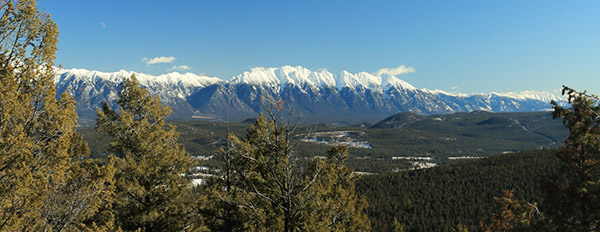Home »

Groundhog Day Rocky Mountain splendour
And some notable night sky sights in romantic February
By Dan Hicks
Op-Ed Commentary
(Unless otherwise specified, times cited are for the evening of February 6 & the predawn of February 7.)
Even the most myopic of groundhogs would appreciate this magnificent winter vista, enjoyed by a hiking party of ten or so Rocky Mountain Naturalists on Groundhog Day, who marched westward on a secret serpentine trail to Whiskey Jack Hill through a Douglas fir forest with a negligible snow depth; snowshoes were unnecessary – hiking poles were the best assists, cleats were helpful in a few icy places. The winter sun rose only to a lowly 24 degrees on our southern meridian (solar noon 12:56 MST), so the air remained cool within a forest of shadows, but we were warmed by a bonfire and roasted wieners.
The sun will slowly climb in our sky, attaining an altitude of 40 degrees on our March 19 spring equinox (solar noon 13:50 MDT) and 64 degrees on our June 20 summer solstice (solar noon 13:44 MDT). Although this splendid Rocky Mountain prospect might seem like an ideal 2070 home for CranHenge, from which equinox and solstice sunrises could be commemorated, the Whiskey Jack Hill summit is simply too small, even for such a minimalist astronomical monument.
Under clear winter skies, Planet Venus is our brightest Evening Star, high in the western sky where, in its best evening apparition in the northern hemisphere since 2012, it will maintain its unrivalled planetary prominence into May; a brilliant minus 4.1 magnitude now, brightening to minus 4.7 by late April.
Visible at an altitude of 34 degrees by 18:00 MST, Venus remains in our sky until it finally sets due west at 21:36. Our waxing crescent moon rendezvouses within six degrees of the radiant planet on February 27. Darkened in the January 9 evening electricity outage, Cranbrook was a city illuminated by moonlight with Venus as our natural lamp – glowing above the western horizon.
Our second evening sky planet is Mercury, a low minus 1.0 magnitude dimmer Evening Star apparition, 25 degrees below and to the right of Venus, setting in the south-southwest at 19:26 MST; Mercury’s last visit was in late November and early December – as our Morning Star.
Predawn planets Mars, Jupiter, and Saturn rise before the sun; respectively at 05:04, 06:28, and 07:04. When our waning crescent moon rises in the February 18th predawn at 04:53 in the southeast, joining the tri-planet line-up, it will be occulting Mars (magnitude 1.2), but at 05:55, the planet will egress from behind the moon’s unlighted limb – emerging magically from the darkness (see chart). However, at the moment of egress, the moon-Mars duo will have attained only a seven degree altitude, so a good view of the southeastern horizon will be essential to catch this stellar voodoo performance.
 Our February full moon is the Snow Moon, rising on the 8th (Saturday) at 17:09 MST in the east-northeast (41 minutes before sunset), attaining maximum illumination on the 9th at 00:33, and setting at 08:42 in the west-northwest (39 minutes after sunrise). The Snow Moon moniker seems somewhat ironic given the present absence of snow here in Cranbrook but, as this full moon comes only six days before Saint Valentine’s Day, it may be our most romantic moon – beheld by the sincerest sweethearts – together – as the divine sphere glides upward over the Rockies.
Our February full moon is the Snow Moon, rising on the 8th (Saturday) at 17:09 MST in the east-northeast (41 minutes before sunset), attaining maximum illumination on the 9th at 00:33, and setting at 08:42 in the west-northwest (39 minutes after sunrise). The Snow Moon moniker seems somewhat ironic given the present absence of snow here in Cranbrook but, as this full moon comes only six days before Saint Valentine’s Day, it may be our most romantic moon – beheld by the sincerest sweethearts – together – as the divine sphere glides upward over the Rockies.
One of the classic moon-songs from the Great American Songbook, Cole Porter’s “In the Still of the Night” (1937) was last popular on the charts in 1960 as sung by Dion & the Belmonts. Cranbrookers were treated to a Cole Porter music extravaganza at the Key City Theatre this January of 2020 in Galen Olstead’s thoroughly entertaining production of the musical “Anything Goes” (1987).
In the Still of Night (excerpt)
Do you love me, as I love you
Are you my life to be, my dream come true
Or will this dream of mine fade out of sight
Like the Moon growing dim, on the rim of the hill
In the chill, still, of the night
However chilling the doubtful-love despondency intoned by Porter’s poetic lyrics, eternal Luna is herself ever reliable – for after setting, she always rises again to faithfully illuminate our stillest nights.

Orion, our great winter constellation, is threatened with being catastrophically redesigned. Betelgeuse, the figure’s upper left shoulder star (from our perspective), a pulsating magnitude-varying-triple-cycle red supergiant whose historic intrinsic magnitude was a blazing minus 6 – 25,000 times brighter than our sun (at a mere plus 5), 700 light years away – has undergone some unprecedented dimming recently. In the last three months of 2019, Betelgeuse’s status diminished from that of the 10th brightest star in our global night sky to the 21st; from a visual 0.5 magnitude to 1.64 now – becoming 25% less luminous. But as Betelgeuse dims, it has cooled and ballooned, noteworthy for a misshapen star whose monstrous mass already fluctuated between a radius equivalent to the orbit of Mars and a radius equivalent to the orbit of Jupiter; essentially, this gaseous entity is a red-hot vacuum shell, 20 times more massive than our sun, but with an outer density merely 1/10,000th that of the air we breathe.
Betelgeuse is imminently fated to “blow up real good” – disintegrating as a spectacular super-exciting supernova, possibly appearing as a stellar apparition in our daytime sky, robbing Venus of her glory. Alas, “imminent” in astronomical terms means any time between today and the next 100,000 years; be consoled and guided by Aesop’s ancient supernova entertainment axiom – “be careful as to what you wish upon a star, lest that wish comes true – far too close to you.”
Sources: Observer’s Handbook 2020 (Royal Astronomical Society of Canada), Skyandtelescope.com, SkyNews Magazine Jan-Feb 2020, & Timeanddate.com.
Skyandtelescope.com features a monthly Sky Tour Podcast, & an Interactive Sky Chart which can easily be set to represent the night sky anywhere.
The Canadian Skynews.ca website has just debuted, read about inbound binocular Comet PanSTARRS C/2017 T2 which itself will debut in May; this is the 159th comet which the vigilant Hawaiian search-telescope has detected.
The Rocky Mountain Naturalists’ next meeting will be on March 18 (7 p.m.) at the College of the Rockies (Rm 210) (see Rockymountainnaturalists.org).
For more on CranHenge, Penhenge, and voracious roadkill-loving ravens who will say “nevermore” upon our apocalyptic demise – search “rocky mountain sunrise gold” on this website.
 Lead image and above: The Steeples, looking east from Whiskey Jack Hill, north of Cranbrook. February 2, 2020. Dan Hicks photos
Lead image and above: The Steeples, looking east from Whiskey Jack Hill, north of Cranbrook. February 2, 2020. Dan Hicks photos








